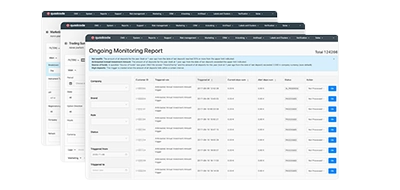กลับ
Contents
การซื้อขายระหว่างวัน: ทุกสิ่งที่คุณควรรู้


Iva Kalatozishvili
Business Development Manager

Vitaly Makarenko
Chief Commercial Officer
การซื้อขายแบบรายวันเป็นรูปแบบการซื้อขายที่จำกัดเพียงหนึ่งเซสชันการซื้อขาย สถานะทั้งหมดจะเปิดและปิดภายในหนึ่งวัน
ผู้ซื้อขายระหว่างวันมุ่งเน้นไปที่การแกว่งตัวระหว่างวันในระยะสั้นและจะไม่ถือตำแหน่งเป็นเวลานาน
ในบทความนี้เราจะเน้นประเด็นต่อไปนี้:
- การซื้อขายภายในวันหมายถึงอะไรและทำงานอย่างไร?
- รูปแบบการเทรดพื้นฐานมีความแตกต่างกันอย่างไรบ้าง?
- การซื้อขายภายในวันมีข้อดีและข้อเสียอะไรบ้าง?
- หลักการสำคัญของการซื้อขายภายในวันมีอะไรบ้าง?
- เทรดเดอร์ควรใช้กลยุทธ์ใดเมื่อเปิดตำแหน่งระหว่างวัน?
การซื้อขายภายในวันจัดอยู่ในประเภทของรูปแบบการซื้อขายพื้นฐานที่ประกอบด้วย การเก็งกำไร การเทรดแบบสวิง และการซื้อขายแบบตำแหน่ง . ความแตกต่างหลักๆ มีอะไรบ้าง?
ความแตกต่างระหว่างรูปแบบการซื้อขายขั้นพื้นฐาน
เทรดเดอร์แต่ละรายมีลักษณะเฉพาะที่แตกต่างกันไปในวิธีการเทรด ระยะเวลาในการถือสถานะ และเครื่องมือเทรดที่ควรใช้ในการวิเคราะห์ความเคลื่อนไหวของราคาในอนาคต มีรูปแบบการเทรดพื้นฐานอยู่ 4 แบบ:
- การเทรดแบบ Scalp (Scalping) รูปแบบนี้หมายถึงการถือสถานะในระยะเวลาสั้นมาก เทรดเดอร์แบบ Scalp จะถือสถานะตั้งแต่ไม่กี่วินาทีไปจนถึงหลายนาที วิธีการนี้มีเป้าหมายเพื่อเปิดคำสั่งซื้อขายจำนวนมากและรับกำไรจำนวนเล็กน้อยแต่บ่อยครั้ง เทรดเดอร์จำเป็นต้องมีส่วนร่วมในตลาดอย่างเต็มที่ วิเคราะห์การเคลื่อนไหวของราคาที่น้อยที่สุด และค้นหาจุดที่ดีที่สุดเพื่อเข้าและออกจากตลาดอย่างรวดเร็ว
- เดย์เทรด (เดย์เทรด) กฎหลักของสไตล์การเทรดนี้คือการปิดสถานะทั้งหมดก่อนที่ตลาดจะปิด เทรดเดอร์จะเปิดและปิดสถานะภายในช่วงเวลาเดียวกัน พวกเขาได้รับกำไรจากการเคลื่อนไหวของตลาดในระยะสั้น แต่มีเวลาวิเคราะห์ตลาดอย่างแม่นยำมากกว่าเมื่อเทียบกับการเก็งกำไรแบบ Scalping
- การเทรดแบบสวิงเทรดเดอร์ (Swing Trading) คือการถือสถานะไว้หลายวันหรือหลายสัปดาห์ เป้าหมายหลักของสวิงเทรดเดอร์คือการทำความเข้าใจแนวโน้มตลาดปัจจุบันและใช้ประโยชน์จากการเคลื่อนไหว เทรดเดอร์มองหาจุดสวิงสูงสุดเมื่อราคาสินทรัพย์สูงขึ้น หรือจุดสวิงต่ำสุดเมื่อราคาลดลง
- การเทรดแบบ Position Trading วิธีนี้คล้ายกับการลงทุนมากกว่าการเทรด เพราะคุณสามารถถือครองสถานะได้หลายสัปดาห์ หลายเดือน หรือแม้แต่หลายปี ความผันผวนของตลาดในระยะสั้นไม่ส่งผลกระทบต่อการคาดการณ์ของเทรดเดอร์แบบ Position Trading แต่จะมุ่งเน้นไปที่แนวโน้มตลาดในระยะยาวและปัจจัยทางเศรษฐกิจมหภาค
คุณสมบัติหลักของการซื้อขายระหว่างวัน
- ผู้ซื้อขายเปิดสถานะและจำเป็นต้องปิดสถานะเหล่านั้นภายในเซสชันการซื้อขายเดียวกัน
- สิ่งสำคัญที่สุดคือเครื่องมือวิเคราะห์ทางเทคนิค เทรดเดอร์ใช้การผสมผสานตัวบ่งชี้ต่างๆ เพื่อทำความเข้าใจว่าราคาสินทรัพย์จะขึ้นหรือลงภายในระยะเวลาอันใกล้นี้
- จำนวนสถานะค่อนข้างสูง เทรดเดอร์รายวันมักจะเปิดสถานะมากกว่า 10 สถานะ และได้กำไรเล็กน้อยจากแต่ละสถานะ
- กำไรเฉลี่ยต่อตำแหน่งอยู่ที่ 2-3%
- ผู้ค้าใช้ประโยชน์ ประเภทสินทรัพย์ที่แตกต่างกัน เพื่อเปิดตำแหน่งของตน
การเทรดแบบ Intraday เหมาะกับใคร?
ในแง่หนึ่ง การเทรดแบบอินทราเดย์เทรดเป็นหนึ่งในรูปแบบการเปิดและถือสถานะที่แพร่หลาย ในทางกลับกัน เทรดเดอร์จำเป็นต้องเข้าใจว่าวิธีการดังกล่าวเหมาะสมกับตนเองหรือไม่ เมื่อเทรดเดอร์เลือกรูปแบบที่ผิด พวกเขามักจะขาดทุนอย่างหนัก
ดังนั้น ภาพลักษณ์ของผู้ซื้อขายรายวันที่ประสบความสำเร็จคืออะไร?
- ผู้ประกอบการค้าสามารถตัดสินใจได้อย่างรวดเร็วและสามารถวิเคราะห์ข้อมูลจำนวนมากได้ภายในระยะเวลาสั้นๆ
- ผู้ประกอบการจะไม่ถูกอิทธิพลจากความเครียดเมื่อทำงานภายใต้กำหนดเวลาที่กระชั้นชิด
- ผู้ประกอบการค้าจะมีความสามารถในการต้านทานความเครียดสูง สามารถควบคุมอารมณ์ และตัดสินใจด้วยความใจเย็น

เมื่อความจำเป็นในการตัดสินใจอย่างรวดเร็วและวิเคราะห์ตลาดภายในระยะเวลาที่กระชั้นชิดทำให้เกิดข้อผิดพลาดและความเครียด ให้เปลี่ยนรูปแบบการซื้อขายของคุณเป็นการซื้อขายแบบสวิงหรือแบบตำแหน่ง
ประเภทของการซื้อขายระหว่างวัน
การซื้อขายแบบอินทราเดย์ (Intraday Trading) คือชื่อเรียกของรูปแบบการซื้อขาย แต่ในขณะเดียวกันก็รวมถึงรูปแบบการซื้อขายหลายประเภทที่แตกต่างกันออกไป ทั้งวิธีการ กลยุทธ์ และผลกำไรที่เป็นไปได้ ต่อไปนี้คือรายการประเภทของการซื้อขายแบบอินทราเดย์:
- การซื้อขายโมเมนตัม
- การซื้อขายแบบ Breakout;
- การซื้อขายแบบกลับด้าน;
- การซื้อขายตามข่าวสาร
มาเจาะลึกการซื้อขายรายวันแต่ละประเภทเพื่อทำความเข้าใจลักษณะเฉพาะของมันกัน
การซื้อขายโมเมนตัม
เทรดเดอร์กำลังมองหาสินทรัพย์ที่กำลังจะแสดงให้เห็นถึงการเคลื่อนไหวของราคาที่แข็งแกร่ง สถานะจะเปิดขึ้นในทิศทางของแนวโน้มปัจจุบัน ไม่ว่าจะเป็นขาขึ้นหรือขาลง เป้าหมายหลักคือการขี่คลื่นและรอจนกว่าแนวโน้มจะพร้อมสำหรับการกลับตัว การเทรดแบบโมเมนตัมสามารถใช้ได้กับสินทรัพย์ทุกประเภท แต่เทรดเดอร์มักจะเลือกหุ้นบ่อยกว่า
การซื้อขายแบบ Breakout
การซื้อขายประเภทนี้ขึ้นอยู่กับการระบุระดับแนวรับและแนวต้าน เทรดเดอร์มืออาชีพใช้ตัวบ่งชี้ที่แตกต่างกันเพื่อแสดงภาพช่องที่ราคาสินทรัพย์กำลังเคลื่อนไหวอยู่ภายใน ตัวบ่งชี้เหล่านี้ ได้แก่ Keltner Channel, Donchian Channel, Bollinger Bands และอื่นๆ เมื่อราคาแตะขอบบนหรือขอบล่างของช่อง มีโอกาสสูงที่ราคาจะกลับเข้าสู่ช่อง ในขณะเดียวกัน การทะลุขอบเหล่านั้นถือเป็นสัญญาณบ่งชี้แนวโน้มที่กำลังจะมาถึง เทรดเดอร์จะเปิดสถานะเมื่อราคาสินทรัพย์ทะลุขอบใดขอบหนึ่งของช่อง
การซื้อขายแบบกลับด้าน
แนวโน้มหนึ่งย่อมมีการเปลี่ยนแปลงโดยอีกแนวโน้มหนึ่งไม่ช้าก็เร็ว และตลาดการเงินทั้งหมดทำงานตามหลักการนี้ เทรดเดอร์มืออาชีพอาศัยตัวบ่งชี้การวิเคราะห์ทางเทคนิคและรูปแบบกราฟเพื่อระบุระดับราคาที่สินทรัพย์มีภาวะซื้อมากเกินไปหรือขายมากเกินไป ดังนั้น พวกเขาจึงเปิดสถานะในทิศทางตรงกันข้ามเพื่อรอการกลับตัวของแนวโน้ม สำหรับตัวบ่งชี้ที่ใช้ในการเทรดแบบกลับตัว RSI และ Stochastic ถือเป็นเครื่องมือที่แพร่หลายที่สุด เมื่อพูดถึงประเภทของรูปแบบกราฟการกลับตัว ได้แก่ Hammer, Hanging man, Shooting star เป็นต้น
การซื้อขายตามข่าวสาร
ตามชื่อของมัน เทรดเดอร์จะคาดการณ์จากข่าว พวกเขาติดตามเหตุการณ์สำคัญๆ ที่เกิดขึ้นในตลาดการเงิน (รายงานผลประกอบการ การนำเสนอต่อสาธารณะของนักลงทุนรายใหญ่ การอัปเดตดัชนีต่างๆ เหตุการณ์ทางการเมือง เศรษฐกิจ และอื่นๆ) และทำความเข้าใจว่าราคาของสินทรัพย์กำลังสูงขึ้นหรือต่ำลง เมื่อพูดถึงการซื้อขายตามข่าว คุณจำเป็นต้องตัดสินใจอย่างรวดเร็วในเสี้ยววินาที
ตัวบ่งชี้ที่ใช้ในการซื้อขายระหว่างวัน
การซื้อขายภายในวันส่วนใหญ่จะอิงตามการวิเคราะห์ทางเทคนิค ดังนั้น เทรดเดอร์มืออาชีพจึงต้องพึ่งตัวบ่งชี้และรูปแบบต่างๆ ที่จะช่วยให้พวกเขาเข้าใจการเคลื่อนไหวของราคาเพิ่มเติม
นี่คือตัวบ่งชี้ที่แพร่หลายที่สุดที่ใช้ในการซื้อขายภายในวัน:
- ค่าเฉลี่ยเคลื่อนที่ ค่าเฉลี่ยเคลื่อนที่ช่วยปรับความผันผวนของราคาและลดสัญญาณรบกวนในตลาด ทำให้เทรดเดอร์สามารถเข้าใจทิศทางของแนวโน้มปัจจุบันได้ เทรดเดอร์สามารถกำหนดช่วงเวลาที่จำเป็นเพื่อให้มองเห็นแนวโน้มที่กำลังดำเนินอยู่ได้กว้างขึ้น
- แถบ Bollinger Bands ตัวบ่งชี้นี้ประกอบด้วยเส้นสามเส้น โดยเส้นกลางคือ SMA 20 (ค่าเฉลี่ยเคลื่อนที่แบบง่าย คำนวณจากช่วงเวลา 20 วัน) แถบ Bollinger Bands แสดงให้เห็นว่าสินทรัพย์อยู่ในภาวะซื้อมากเกินไป (overbought) หรือขายมากเกินไป (oversold)
- RSI (Relative Strength Index) ตัวบ่งชี้นี้ค่อนข้างใกล้เคียงกับ Bollinger Bands เนื่องจากเทรดเดอร์ใช้ดัชนีนี้เพื่อทำความเข้าใจว่าสินทรัพย์ใดมีภาวะซื้อมากเกินไป (overbought) หรือขายมากเกินไป (oversold) RSI แสดงสถานการณ์ตลาดในระดับตั้งแต่ 0 ถึง 100
- MACD (Moving Average Convergence Divergence) ตัวบ่งชี้นี้ให้สัญญาณแก่เทรดเดอร์ว่าแนวโน้มปัจจุบันจะกลับตัวหรือดำเนินต่อไป เครื่องมือนี้แสดงด้วยฮิสโทแกรมที่แสดงตัวบ่งชี้แนวโน้มขาขึ้นและขาลง
กลยุทธ์ที่มีประสิทธิภาพสำหรับการซื้อขายระหว่างวัน
การผสมผสานของ EMA, MACD, RSI
เราต้องเพิ่มอินดิเคเตอร์ MACD ที่มีการตั้งค่าเริ่มต้น จากนั้นจึงใช้ RSI โดยคงการตั้งค่าเริ่มต้นไว้เช่นกัน สำหรับค่าเฉลี่ยเคลื่อนที่ ให้เพิ่มค่าเฉลี่ยเคลื่อนที่สองค่า คือ ค่าเฉลี่ยเคลื่อนที่แบบเอ็กซ์โพเนนเชียลที่มีระยะเวลา 7 วัน และค่าเฉลี่ยเคลื่อนที่แบบ EMA อีกตัวที่มีระยะเวลา 26 วัน จะเห็นภาพต่อไปนี้ในกราฟ:

เปิดตำแหน่งตามเกณฑ์ต่อไปนี้:
- เส้น EMA 7 ตัดกับเส้น EMA 26 จากล่างขึ้นบน ดัชนี MACD กำลังขยับขึ้น และดัชนี RSI สูงกว่า 50 เปิดสถานะซื้อ
- เส้น EMA 26 ตัดกับเส้น EMA 7 จากบนลงล่าง ดัชนี MACD กำลังลดลง และดัชนี RSI ต่ำกว่า 50 เปิดสถานะขาย
กลยุทธ์ริบบิ้น SLM
กลยุทธ์นี้ทั้งเรียบง่ายและมีประสิทธิภาพ คุณต้องเพิ่มเฉพาะตัวบ่งชี้ค่าเฉลี่ยเคลื่อนที่ (เลขชี้กำลัง) เท่านั้น เลือกเส้น EMA ที่มีระยะเวลา 8 วัน, 13 วัน และ 21 วัน

เปิดตำแหน่งตามเกณฑ์ต่อไปนี้:
- เส้น EMA 8 ตัดกับเส้น EMA 13 และ EMA 21 จากล่างขึ้นบน เปิดสถานะซื้อบนแท่งเทียนถัดจากแท่งที่ทะลุแนวรับ
- เส้น EMA 8 ตัดกับเส้น EMA 13 และ EMA 21 จากบนลงล่าง เปิดสถานะขาย (Short Position) บนแท่งเทียนถัดจากแท่งที่ทะลุแนวรับ
You may also like

การรวมกันของพาราโบลา SAR และค่าเฉลี่ยเคลื่อนที่
เพิ่ม Parabolic SAR โดยคงการตั้งค่าเริ่มต้นไว้ จากนั้นใช้เส้น SMA ที่มีระยะเวลา 20 วัน

เปิดตำแหน่งตามเกณฑ์ต่อไปนี้:
- เมื่อแท่งเทียนขาขึ้นทะลุเส้น SMA 20 และปิดเหนือเส้นดังกล่าว และ Parabolic SAR ยืนยันสัญญาณ (วงกลมสีเหลืองด้านล่าง) ให้เปิดสถานะซื้อ
- เมื่อแท่งเทียนขาลงทะลุเส้น SMA 20 และปิดต่ำกว่านั้น และ Parabolic SAR ยืนยันสัญญาณ (วงกลมสีเหลืองด้านบน) ให้เปิดสถานะขาย
ข้อดีและข้อเสียของการซื้อขายระหว่างวัน
ข้อดีหลักๆ และจุดอ่อนของรูปแบบการเทรดแบบนี้คืออะไร?
ข้อดีหลักของการซื้อขายภายในวัน:
- เทรดเดอร์สามารถทำกำไรได้ภายในหนึ่งเซสชันการซื้อขาย แม้จะอยู่ในช่วงที่ราคาผันผวนน้อยที่สุดก็ตาม
- เทรดเดอร์ใช้เงินทุนขั้นต่ำเนื่องจากมีเลเวอเรจสูง รูปแบบการซื้อขายแบบนี้สามารถทำได้ตั้งแต่ $10 ถึง $20
- คำสั่ง Stop-loss และ Take Profit ทำให้สามารถควบคุมความเสี่ยงได้ นอกจากนี้ เทรดเดอร์ไม่ได้ถือสถานะของตนข้ามคืน ซึ่งเป็นเหตุผลว่าทำไมพวกเขาจึงควบคุมสถานะของตนได้อย่างสมบูรณ์
ข้อเสียของการซื้อขายภายในวันมีดังต่อไปนี้:
- การซื้อขายภายในวันค่อนข้างซับซ้อน ดังนั้นผู้ซื้อขายจึงจำเป็นต้องมีความรู้เชิงลึกเกี่ยวกับการทำงานของการวิเคราะห์ทางเทคนิค
- กรอบเวลาต่ำ (M1, M5, M15 เป็นต้น) มีลักษณะ "สัญญาณรบกวน" บ่อยครั้ง และผู้ซื้อขายอาจได้รับสัญญาณเท็จ
- รูปแบบนี้ต้องการให้ผู้ซื้อขายสามารถวิเคราะห์ข้อมูลจำนวนมากและตัดสินใจได้อย่างรวดเร็ว
- การซื้อขายระหว่างวันเชื่อมโยงกับภาระการวิเคราะห์และอารมณ์ของเทรดเดอร์ที่สูงมาก ดูเหมือนว่าจะมีความเสี่ยงจากการซื้อขายมากเกินไป
บรรทัดล่าง
การซื้อขายแบบอินทราเดย์ถือเป็นรูปแบบการซื้อขายที่ได้รับความนิยมมากที่สุด เทรดเดอร์สามารถเปิดและปิดสถานะได้ภายในหนึ่งเซสชันการซื้อขาย รูปแบบนี้ให้ผลกำไรสูงภายในระยะเวลาอันสั้น เทรดเดอร์จำเป็นต้องมีความเชี่ยวชาญในการวิเคราะห์ทางเทคนิคและสามารถตัดสินใจได้อย่างรวดเร็วโดยอิงจากสัญญาณที่ได้รับ
อัปเดต:
19 ธันวาคม 2567




